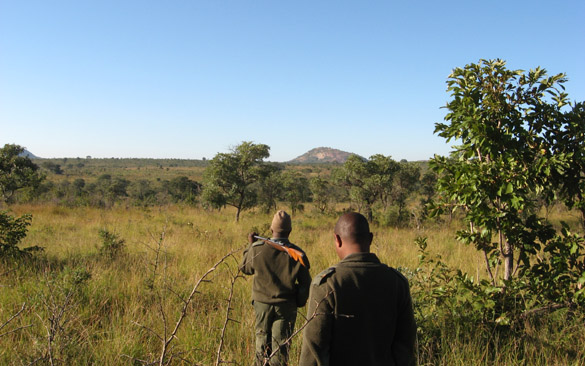In the waning pre-dawn blackness of the South African bush, Pat Masabo slides three long, golden bullets into the rifle chamber and locks the bolt handle shut. He clips his ammunition belt around his waist, hands me his backpack, and tells us that during the next three hours we are to walk in a single file line, and that under no circumstances could there be any talking unless he gives the okay.
We were about to leave the safety of our open-air jeep and venture on foot into the unpredictability of Kruger National Park, where hungry lions could attack, elephants could charge, and leopards could pounce. Pat and his trusty rifle were our only protection; the chilly morning air did little to cool my nerves.


Animal poaching is an ongoing threat to wildlife in South Africa. According to a recent report by Traffic, an organization that monitors the global wildlife trade, 210 rhinos were killed in the country between 2006 and 2009; SANParks claims that 92 additional rhinos had been slaughtered through May of this year, including 33 in Kruger alone.
Rhinos are most coveted for their horns, which are often peddled off to countries in Asia for medicinal use; all animals, however, are viewed simply as sustenance by the desperate, impoverished people in South Africa and neighboring countries like Mozambique and Zimbabwe. When I raised the topic over breakfast, Pat expressed empathy for those suffering people, but still didn’t excuse the act of poaching under any circumstances. “If it were me,” he deadpanned, “I’d give the death sentence for killing an animal illegally—or I’d just shoot the poacher on sight.”
Pat went on and thoughtfully discussed the difficulties that anti-poaching units face in Kruger with limited funding and so much ground to cover. He also praised the park’s decision to pave just a small percentage of the land—about 2% of the roughly 5 million acres—and to prohibit any visitors from venturing off those roads.
In places like Zimbabwe, as well as in private parks where no such rules are in place and off-roading in protected habitats is tolerated, eager-to-please guides often end up chasing down and eventually cornering frightened wildlife to please demanding clients who want close-up photos of a leopard, a lion, or a cheetah in its “natural” habitat.
The unfortunate reality is that poachers don’t just kill animals, they salvage whatever they can from those that are already dead. For this reason, Kruger Park officials collect tusks and horns from dead animals and auction them on the open market, with proceeds going back into the park’s reserves. Sometimes, it seems, the best way for Kruger to win is to beat their opponents at their own game.
We spotted a line of kudu far off in the distance during breakfast, a small herd of impalas peering at us curiously from behind a line of acacia trees, and a hyena bounced past us in the tall brown grass, but there were no lion attacks, no elephant charges, no leopard pounces. Our lives never hung in the balance, and Pat’s rifle, this time, functioned as nothing more than an impressive accessory.
Our guides were clearly disappointed, and so, too, was Jeff and two others in the group who sulked throughout the walk and acted totally disinterested in Pat’s lessons about the bush, about Kruger, and about South Africa. Upon returning to Pretoriuskop, they sullenly clambered off the jeep and skulked away, without so much as a thank you, nevermind a perfunctory tip, for the time our guides spent with us with that morning.
Kruger National Park is not a zoo, and wildlife sightings are never guaranteed, whether on safari or on a bush walk. The thrill of adventure and the risk of (semi-controlled) danger was the lure for all of us that morning, but in the absence of those close encounters, I gained a broader appreciation for the land, the animals, and the people who help protect and maintain this special place. Kruger seems to be in good hands.
In the end, our bush walk wasn’t about action and adventure; it was about education and understanding.